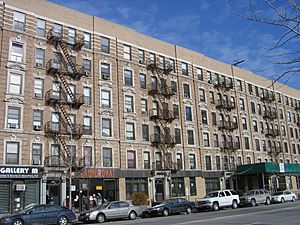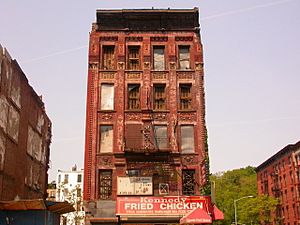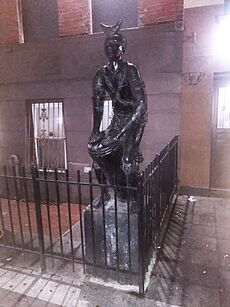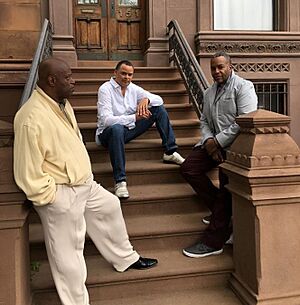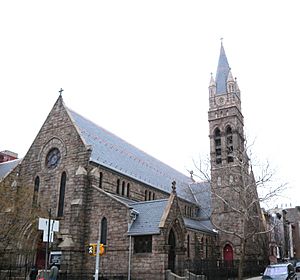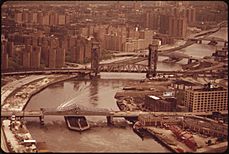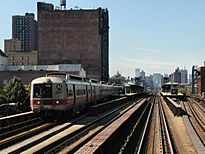Harlem facts for kids
Quick facts for kids
Harlem
|
|
|---|---|
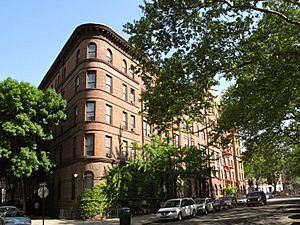
Apartment buildings next to Morningside Park in Harlem
|
|
| Nickname(s):
"Heaven", "Black mecca"
|
|
| Country | |
| State | |
| City | New York City |
| Borough | Manhattan |
| Community District | Manhattan 10 |
| Founded | 1660 |
| Founded by | Peter Stuyvesant |
| Named for | Haarlem, Netherlands |
| Area | |
| • Total | 1.400 sq mi (3.63 km2) |
| Population | |
| • Total | 197,052 |
| Economics | |
| • Median income | ,708 |
| Time zone | UTC−5 (Eastern) |
| • Summer (DST) | UTC−4 (EDT) |
| ZIP Codes |
10026, 10027, 10030, 10031, 10035, 10037, 10039
|
| Area code | 212, 332, 646, and 917 |
Harlem is a well-known neighborhood in New York City, located in Manhattan. It is generally found in the northern part of Manhattan. Its borders are roughly the Hudson River to the west, the Harlem River and 155th Street to the north, Fifth Avenue to the east, and Central Park North (110th Street) to the south.
Harlem was first a Dutch village, officially started in 1658. It was named after the city of Haarlem in the Netherlands. Over time, Harlem has seen many changes in its population and economy. In the late 1800s, many Jewish and Italian families lived there. Then, in the early 1900s, many African-American residents moved to Harlem during the Great Migration.
In the 1920s and 1930s, Central and West Harlem became the heart of the Harlem Renaissance. This was a huge cultural movement for African Americans. After World War II, the neighborhood faced tough times with more challenges. However, in the 21st century, Harlem has seen many improvements and new growth.
The area has good public transportation, including the New York City Subway and local buses. It also has many schools and is close to colleges like Columbia University.
Contents
Harlem: A Famous Neighborhood
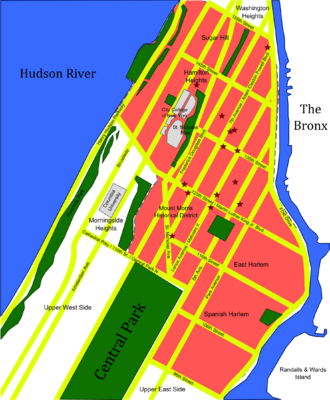
Harlem is located in Upper Manhattan. The larger Harlem area includes three main parts: West, Central, and East Harlem. These areas stretch from the Harlem River and East River in the east to the Hudson River in the west. They are located between 155th Street in the north and a changing southern border. This southern border runs along 96th Street east of Fifth Avenue, 110th Street near Morningside Park, and 125th Street west of Morningside Park.
Central Harlem is the main part of Harlem. It is bordered by Fifth Avenue to the east and Central Park to the south. To the west, it has Morningside Park and St. Nicholas Avenue. The Harlem River is to its north. This area includes parks like Morningside Park, St. Nicholas Park, and Jackie Robinson Park. Marcus Garvey Park (also called Mount Morris Park) separates Central Harlem from East Harlem.
West Harlem includes neighborhoods like Manhattanville, Hamilton Heights, and Sugar Hill. It is bordered by 110th Street to the south and 155th Street to the north. The Hudson River is to its west. This part of Harlem also has parks like West Harlem Piers and Riverbank State Park.
East Harlem, also known as Spanish Harlem or El Barrio, is bordered by East 96th Street to the south and East 138th Street to the north. Fifth Avenue is to its west, and the Harlem River is to its east. Thomas Jefferson Park is one of the parks in East Harlem.
History of Harlem
Before Europeans arrived, the area of Harlem was home to the Manhattans, a Native American tribe. They lived in the area in a semi-nomadic way. Some of them farmed the flat lands of Harlem. The first European settlements were set up between 1637 and 1639.
During the American Revolution, the British army burned Harlem down. It took a long time for the area to rebuild and grow. After the American Civil War, Harlem started to boom economically around 1868. More people moved to Harlem, especially those who were poor and of Jewish or Italian background. New train lines, like the New York and Harlem Railroad, helped Harlem connect to other parts of Manhattan. This helped the area grow even more.
Over time, the number of Jewish and Italian residents decreased. At the same time, more Black and Puerto Rican people moved in. The Great Migration in the early 1900s brought many Black people from the Southern United States to northern cities like New York. They wanted to escape unfair Jim Crow laws, find better jobs, and get good education for their children. By 1930, Central Harlem was about 70% Black.
Around the end of World War I, Harlem became known for the New Negro movement. This led to the Harlem Renaissance, a period of amazing art, poetry, novels, theater, and visual arts. So many Black people moved to Harlem that it changed the area a lot.
However, the Great Depression in the 1930s hit Harlem hard. Many people lost their jobs. In the early 1930s, about 25% of people in Harlem were out of work. This problem continued for decades. Some jobs that Black New Yorkers traditionally held were taken by other groups. Also, big industries left New York City after 1950. During this time, there were some difficult periods in Harlem, including in 1935 and 1943.
After World War II, Harlem saw more big changes. In the late 1950s and early 1960s, residents protested for better housing conditions. Groups like the Congress of Racial Equality worked to make landlords improve buildings. They wanted landlords to fix problems like rats and provide heat in winter. The city also built public housing projects to offer safer homes. However, local groups eventually stopped new projects from being built.
Education was also a big concern. In the 1960s, many Harlem students were behind in reading and math. In 1964, residents held school boycotts to highlight these issues. After World War II, Harlem was no longer home to most of the city's Black population. But it remained a very important cultural and political center for Black New York.
By the 1970s, many people who could afford to leave Harlem did so. They looked for safer streets, better schools, and nicer homes. Those who stayed were often the poorest. The government tried to help with programs for jobs and housing, but improvements were slow. In 1985, the city started selling off many properties in Harlem. The goal was to help people own homes and improve the neighborhood.
After the 1990s, Harlem began to grow again. Between 1990 and 2006, the population increased by almost 17%. The percentage of Black residents decreased, while the percentage of white residents increased. New buildings and shops along 125th Street also helped to bring new life to Harlem.
Culture and Arts in Harlem

In the 1920s and 1930s, Central and West Harlem were at the center of the "Harlem Renaissance". This was a time when Black artists created amazing works like never before in America. While musicians and writers from Harlem are very famous, the community also had many actors and theater groups. These included the New Heritage Repertory Theater and the American Negro Theater.
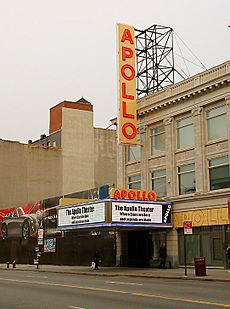
The Apollo Theater opened on 125th Street in 1934. The Savoy Ballroom, on Lenox Avenue, was famous for swing dancing. It was even mentioned in a popular song called "Stompin' at the Savoy". In the 1920s and 1930s, there were over 125 entertainment spots in central Harlem. These included clubs, cafes, theaters, and dance halls.
133rd Street was known as "Swing Street" during the Prohibition era. It was famous for its jazz clubs and secret bars. Some jazz clubs, like the Cotton Club, where Duke Ellington played, were only for white people. But others, like the Renaissance Ballroom and the Savoy Ballroom, welcomed everyone.
In 1936, Orson Welles put on his Black Macbeth play at the Lafayette Theater in Harlem. Many old theaters were torn down or turned into churches. Harlem did not have a permanent performance space for a long time. Then, the Gatehouse Theater opened in 2006 in an old building on 135th Street.
From 1965 to 2007, Harlem was home to the Harlem Boys Choir. This was a famous choir and education program for young boys. The Girls Choir of Harlem was also started in 1989.
From 1967 to 1969, the Harlem Cultural Festival took place in Mount Morris Park. This festival was also called "Black Woodstock". Famous artists like Stevie Wonder performed there.
Harlem also hosts the largest African American Day Parade. This parade celebrates the culture of the African diaspora in America. It started in 1969 with Congressman Adam Clayton Powell Jr. as the first Grand Marshal.
Arthur Mitchell, a dancer, started the Dance Theatre of Harlem in the late 1960s. It is a school and company for classical ballet. The company has performed all over the world. Many theater artists began their careers at this school.
By the 2010s, new restaurants and shops were opening in Harlem. At the same time, some residents worked to keep the neighborhood's original feel. In 2013, residents protested a new farmers market that would close a street.
The Uptown Night Market started in 2021. It celebrates food, community, and culture. It is one of the biggest night markets in Manhattan. It features music, arts and crafts, and lots of food.
Music in Harlem
Many famous R&B and Soul groups started in Harlem. These include The Main Ingredient, Frankie Lymon & The Teenagers, Black Ivory, Cameo, Keith Sweat, and Freddie Jackson.
Harlem has also contributed a lot to hip-hop music. Artists like Doug E. Fresh, Big L, Kurtis Blow, and The Diplomats are from Harlem. Harlem is also where popular hip-hop dances like the Harlem shake and Chicken Noodle Soup began.
In classical music, Harlem has groups like the Harlem Chamber Players and the Harlem Quartet. In the 1920s, Black pianists in Harlem created their own jazz piano style called stride. This style was very important in early jazz.
Harlem's Languages
In 1938, jazz bandleader Cab Calloway wrote the first dictionary by an African American. It was called Cab Calloway's Cat-ologue: A "Hepster's" Dictionary. This book became the official guide to jive language at the New York Public Library. In 1939, Calloway wrote another book to teach people how to use the words from his dictionary. He published several versions until 1944. Poet Lemn Sissay said that Cab Calloway was "taking ownership of language" for a people whose own languages had been taken away.
Churches and Other Religions
Religion has always been very important in Black Harlem. The area has over 400 churches. Major Christian groups include Baptists, Pentecostals, Methodists, Episcopalians, and Roman Catholics. The Abyssinian Baptist Church has been very important because of its large number of members and its many properties. The Church of Jesus Christ of Latter-day Saints built a church on 128th Street in 2005.
Many churches in Harlem are "storefront churches." These are small churches that meet in empty stores or basements. They might have fewer than 50 members, but there are hundreds of them. Other churches are very old, large, and considered important landmarks.
Harlem also has mosques, like the Malcolm Shabazz Mosque No. 7. Judaism is also present in Harlem with the Old Broadway Synagogue.
Famous Places in Harlem
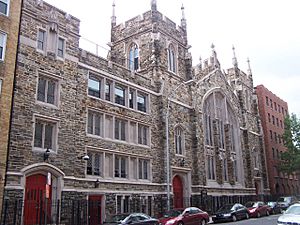

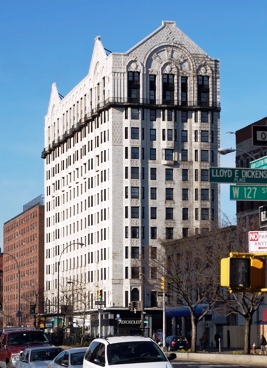
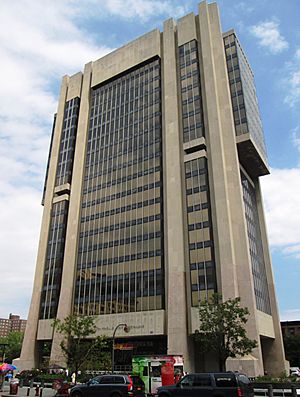
Many places in Harlem are officially recognized as city landmarks or are listed on the National Register of Historic Places. This means they are important historical or cultural sites.
- Abyssinian Baptist Church
- Apollo Theater
- Astor Row (a group of historic houses)
- Dunbar Apartments
- Hamilton Grange
- Harlem River Houses
- Hotel Theresa
- Langston Hughes House
- Morningside Park
- Mount Morris Park Historic District
- Schomburg Collection for Research in Black Culture
- St. Andrew's Church
- St. Nicholas Historic District
Other interesting places to see include:
- Adam Clayton Powell Jr. State Office Building
- Cotton Club
- Frederick Douglass Circle
- Harlem Hospital Center
- Marcus Garvey Park
- Rucker Park (famous basketball court)
- Savoy Ballroom
- Studio Museum in Harlem
- Sylvia's Soul Food
Schools and Libraries
Many adults in Central Harlem have a college education. About 42% of residents aged 25 and older have a college degree or higher. The percentage of students in Central Harlem who are good at math has gone up. It rose from 21% in 2000 to 48% in 2011. Reading skills also improved during that time.
However, more elementary school students in Central Harlem miss school compared to the rest of New York City. About 25% of elementary students miss 20 or more days of school each year. Also, 64% of high school students in Central Harlem graduate on time, which is less than the city average.
Schools in Harlem
The New York City Department of Education runs many public schools in Central Harlem. These include:
- PS 76 A Phillip Randolph (grades PK-8)
- PS 92 Mary Mcleod Bethune (grades PK-5)
- PS 123 Mahalia Jackson (grades PK-8)
- PS 149 Sojourner Truth (grades PK-8)
- PS 154 Harriet Tubman (grades PK-5)
- PS 175 Henry H Garnet (grades PK-5)
- PS 185 the Early Childhood Discovery and Design Magnet School (grades PK-2)
- PS 194 Countee Cullen (grades PK-5)
- PS 197 John B Russwurm (grades PK-5)
- PS 200 The James Mccune Smith School (grades PK-5)
- PS 242 The Young Diplomats Magnet School (grades PK-5)
- Stem Institute of Manhattan (grades K-5)
- Thurgood Marshall Academy Lower School (grades K-5)
Middle and high schools in Central Harlem include:
- Frederick Douglass Academy (grades 6–12)
- Frederick Douglass Academy II Secondary School (grades 6–12)
- Mott Hall High School (grades 9–12)
- Thurgood Marshall Academy For Learning And Social Change (grades 6–12)
- Wadleigh Secondary School for the Performing and Visual Arts (grades 6–12)
Many students in Harlem also attend charter schools. By 2017, about 36% of students were in charter schools.
Colleges and Universities
Several colleges are located in Harlem. These include the CUNY Graduate School of Public Health and Health Policy, New York College of Podiatric Medicine, City College of New York, and Touro College of Osteopathic Medicine.
Libraries in Harlem
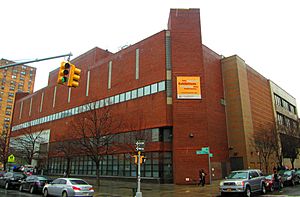
The New York Public Library (NYPL) has several branches in Harlem.
- The Schomburg Center for Research in Black Culture is a research library. It is located at 515 Malcolm X Boulevard. It opened in 1905 and focuses on Black culture. It is a National Historic Landmark.
- The Countee Cullen branch is at 104 West 136th Street.
- The Harry Belafonte 115th Street branch is at 203 West 115th Street. This historic library was built in 1908. It was renamed for the famous entertainer Harry Belafonte in 2017.
- The Harlem branch is at 9 West 124th Street. It is one of the oldest libraries in the NYPL system, operating since 1826.
- The Macomb's Bridge branch is at 2633 Adam Clayton Powell Jr. Boulevard.
Getting Around Harlem
Bridges
The Harlem River separates the Bronx from Manhattan. Several bridges connect Harlem to the Bronx. These include the Willis Avenue Bridge, Third Avenue Bridge, Madison Avenue Bridge, 145th Street Bridge, and Macombs Dam Bridge. In East Harlem, the Wards Island Bridge connects Manhattan to Wards Island. The Triborough Bridge is a large bridge system that connects Queens, East Harlem, and the Bronx.
Public Transportation
The Metropolitan Transportation Authority provides public transportation in Harlem. This includes the New York City Subway and local bus routes. Some bus routes from the Bronx also serve Manhattan. The Metro-North Railroad has a train station at Harlem–125th Street. This station connects Harlem to areas north of the city.
Subway Lines
Harlem is served by several subway lines:
- The IRT Lenox Avenue Line (2 and 3 train) runs between 110th Street and 148th Street.
- The IND Eighth Avenue Line (A, B, C, and D train) runs between 110th Street and 155th Street.
- The IND Concourse Line (B and D train) stops at 155th Street.
Other subway lines also stop nearby:
- The IRT Broadway–Seventh Avenue Line (1 train) serves western Harlem.
- The IRT Lexington Avenue Line (4 5 6 <6> trains) serves East Harlem.
There are also plans for Phase 2 of the Second Avenue Subway to serve East Harlem.
Bus Routes
Many local bus routes run through Harlem:
- Bx6, Bx6 SBS along 155th Street
- Bx19 along 145th Street
- Bx33 along 135th Street
- M1 along Fifth/Madison Avenues
- M2 along Seventh Avenue
- M3 along Manhattan Avenue
- M4 along Broadway
- M60 SBS, M100, M101, M125 along 125th Street
- M7, M102 along Lenox Avenue and 116th Street
- M10 along Frederick Douglass Boulevard
- M116 along 116th Street
See also
 In Spanish: Harlem para niños
In Spanish: Harlem para niños


